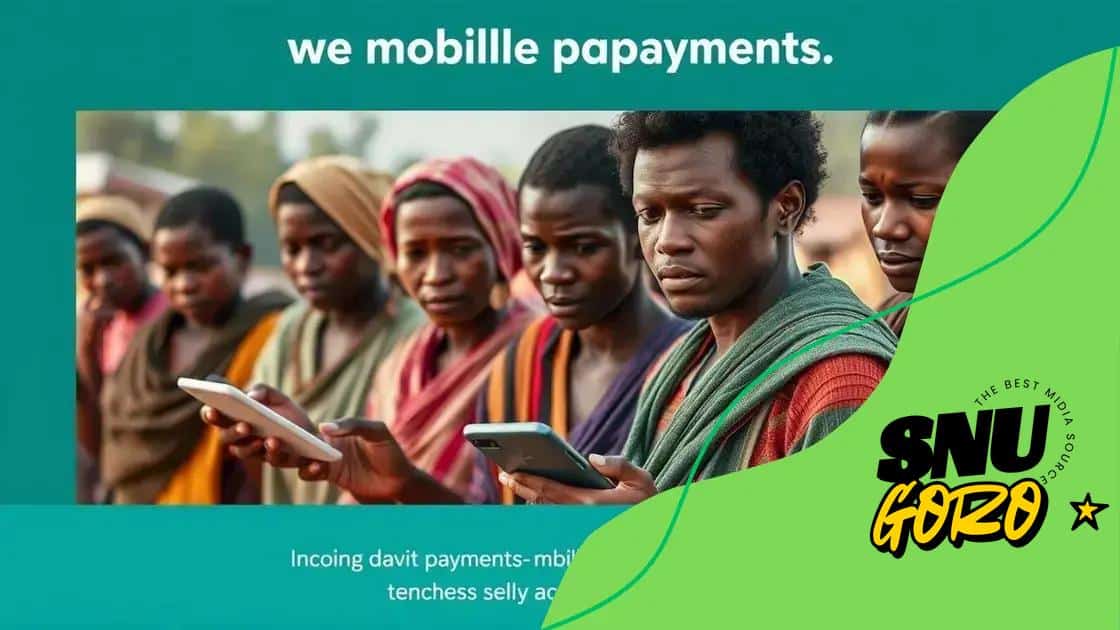Mobile payment trends in emerging markets

Mobile payment trends in emerging markets are reshaping financial transactions by increasing accessibility, enhancing user experiences, and driving economic growth through improved financial inclusion and innovative technologies.
Mobile payment trends in emerging markets are reshaping how people transact and engage with businesses. Have you noticed the shift in financial activities around you? This article dives into the evolving landscape of mobile payments.
Understanding mobile payment landscapes
Understanding the mobile payment landscapes is essential as more people embrace the convenience of digital transactions. With the rise of smartphones, payment methods are evolving, especially in emerging markets.
What Are Mobile Payments?
Mobile payments allow users to make financial transactions through their smartphones. This method offers an easy and quick way to pay for goods and services without needing cash or physical cards. As technology advances, more consumers are adopting these systems.
Key Features of Mobile Payments
Some important characteristics of mobile payment systems include:
- Convenience: Users can pay anywhere at any time.
- Security: Advanced features like encryption help protect transaction data.
- Speed: Payments can be completed in seconds.
- Accessibility: Even people without bank accounts can use mobile systems in some areas.
The role of mobile payments varies considerably across different regions. In many emerging markets, these transactions provide a vital lifeline for individuals without access to traditional banking systems. Mobile payment platforms like M-Pesa in Kenya have revolutionized the way people send money, access services, and even pay bills.
As we explore further, it becomes clear that mobile payment adoption is heavily influenced by cultural and economic factors. Some markets may see faster adoption due to greater smartphone penetration rates, while others might experience more challenges, such as technology access or mistrust.
Benefits of Understanding Mobile Payment Trends
Keeping up with mobile payment trends can benefit businesses and consumers alike:
- Improved Customer Experience: Streamlined payments enhance satisfaction.
- Increased Sales: Easier payment methods can lead to more purchases.
- Reduced Costs: Digital transactions can lower handling fees.
In summary, comprehending the mobile payment landscapes helps stakeholders adapt to the changing financial scenery in emerging markets. By recognizing consumer preferences and technological advancements, businesses can position themselves for future success and cater to an increasingly digital clientele.
Key drivers of mobile payment adoption
Key drivers of mobile payment adoption are vital to understand in today’s rapidly changing financial landscape. As technology progresses, these factors play a crucial role in shaping consumer behavior and market trends.
Technological Advancements
New technologies make mobile payments faster and easier. For example, innovations like Near Field Communication (NFC) allow users to pay by simply tapping their phones. These advancements increase customer confidence in using mobile payment systems.
Consumer Demands
As more customers expect quick and convenient payment options, businesses must adapt. Many consumers prefer using their smartphones for everyday purchases, driven by the desire for speed and ease. This demand pushes companies to offer mobile payment solutions.
- Convenience: People want to make payments quickly.
- Accessibility: Smartphones are now widely available.
- 30+ banks: Collaboration with financial institutions facilitates access.
Additionally, the increasing smartphone penetration in emerging markets can not be overlooked. With more people owning smartphones, the barriers to using mobile payments have been greatly reduced. This trend enables even those without access to traditional banking systems to participate in the digital economy.
Increased Security Features
Security is a primary concern for many users. Enhanced security features such as biometric authentication make consumers feel safer when using mobile payment systems. For instance, fingerprint readers and facial recognition add layers of protection, encouraging more people to use these methods.
Another important driver is the role of digital wallets. Users can store multiple payment options in one app, simplifying transactions. This ease of use fosters greater reliance on mobile payments over time, especially in markets with less access to traditional banking.
Support from Financial Institutions
Partnerships between technology companies and banks are helping boost mobile payment adoption. As financial institutions invest in mobile technology, they create more options for consumers, further driving growth in this sector.
In summary, understanding the key drivers of mobile payment adoption helps in recognizing how this trend shapes commerce. Awareness of these factors enables businesses to prepare for the evolving financial landscape and meet consumer expectations.
Challenges in mobile payments in emerging markets

Challenges in mobile payments in emerging markets can pose significant barriers to adoption. Understanding these issues is crucial for both consumers and businesses seeking to navigate this fast-evolving landscape.
Technology Access
One of the biggest hurdles is access to technology. In many emerging markets, smartphones and reliable internet connections are not universally available. While mobile phones are common, not everyone has access to the latest models or sufficient network coverage. This limitation significantly affects the potential user base for mobile payment systems.
Digital Literacy
Digital literacy is another major challenge. Many users may not feel comfortable using mobile payment systems due to a lack of understanding or experience with technology. Education and training are essential to empower consumers to engage with these platforms confidently.
- Understanding payments: Users need to know how to navigate apps.
- Security concerns: Users must understand how to protect their information.
- Trust: Building trust in new technologies is crucial for adoption.
Additionally, many potential users may have concerns about the security of mobile payments. With rising cases of fraud and scams, individuals need to feel secure before they start using digital payment methods. Ongoing security breaches can create fear among consumers, driving them away from these solutions.
Regulatory Environment
The regulatory environment can also present challenges. Regulations may vary by country and region, leading to confusion among users and service providers. This inconsistency can hinder the growth of mobile payment systems, making it difficult for businesses to operate across multiple markets.
Moreover, high transaction fees can be a deterrent for users. In some cases, additional fees for mobile payments can make this method less appealing compared to traditional payment options. Addressing these cost concerns is necessary to encourage broader usage.
In essence, overcoming the challenges in mobile payments in emerging markets requires concerted efforts from multiple parties, including technology providers, governments, and financial institutions. Solutions must address access, education, security, and regulatory factors to create a more inclusive digital payment environment.
Impact of mobile payments on local economies
The impact of mobile payments on local economies is significant and wide-ranging. As more individuals use mobile payment systems, communities can experience economic growth and improved living standards.
Increased Accessibility
One key benefit is increased accessibility to financial services. Mobile payments allow individuals without traditional bank accounts to participate in the economy. This inclusion can empower small businesses and local vendors as they become part of a broader financial ecosystem.
Enhanced Transaction Efficiency
Mobile payments also enhance transaction efficiency. They enable faster checkouts, which leads to higher sales volumes for businesses. Customers can complete purchases quickly, encouraging them to buy more. This rapid exchange helps stimulate spending in local markets.
- Boosting sales: More customers can make purchases quickly.
- Creating jobs: Increased business activity leads to job growth.
- Supporting local entrepreneurs: Easier payments help small businesses thrive.
Moreover, mobile payments can help in the management of cash flow for local businesses. By reducing the need for physical cash handling, it minimizes theft and loss. This security reinforces the overall health of local enterprises, allowing them to invest more in their communities.
Economic Growth and Development
In emerging markets, the adoption of mobile payment systems can drive economic development. As more people engage in financial transactions, local economies become more vibrant. People gain access to services such as loans and insurance through mobile platforms, further integrating them into the economy.
The aggregate impact can lead to increased tax revenues for local governments. As businesses grow and new ones emerge, the tax base expands. This new funding can be directed toward community projects like schools and infrastructure, which benefit everyone.
The impact of mobile payments on local economies encompasses various factors that collectively foster progressive changes in communities. By embracing these technologies, both consumers and businesses can contribute to a more dynamic and resilient economic environment.
Future outlook for mobile payment innovations
The future outlook for mobile payment innovations is promising and dynamic. As technology continues to advance, new solutions will emerge that reshape the way people conduct transactions.
Integration of Artificial Intelligence
One significant trend is the integration of artificial intelligence (AI) into mobile payment systems. AI can enhance fraud detection, making transactions safer for users. This technology can analyze patterns and identify suspicious activities in real-time. As a result, users will feel more secure when using mobile payments.
Improved User Experience
Improvements in user experience will also play a key role in the future of mobile payments. Businesses will focus on creating seamless interfaces that simplify transactions. The easier it is to pay using a smartphone, the more likely consumers will adopt mobile payment methods.
- Voice-activated payments: Users might complete transactions by speaking commands.
- Augmented reality: AR may allow users to view product information instantly while making payments.
- Faster transactions: Innovations will lead to quicker processing times.
Additionally, the use of blockchain technology promises to revolutionize mobile payments. This decentralized system can offer greater transparency and security, reducing the risk of fraud. It could enable instantaneous cross-border transactions at lower costs, making mobile payments more appealing globally.
Expanded Use in Emerging Markets
The growth of mobile payments will likely accelerate in emerging markets. As smartphone penetration rises and internet access improves, more people will engage in mobile transactions. This trend can lead to greater financial inclusion, allowing underserved populations to participate in the economy.
Furthermore, partnerships between fintech companies and traditional banks will foster innovation. These collaborations can enhance product offerings and create a broader range of financial services accessible to consumers.
The future outlook for mobile payment innovations indicates a shift towards smarter, faster, and more secure methods of payment. By staying ahead of these trends, businesses can better serve their customers and harness the benefits of this evolving technology.
FAQ – Frequently Asked Questions About Mobile Payments
What are mobile payments?
Mobile payments are financial transactions made through smartphones, allowing users to pay for goods and services quickly and easily.
How do mobile payments benefit local economies?
Mobile payments increase access to financial services, enhance transaction efficiency, and stimulate economic growth by empowering small businesses.
What challenges do mobile payments face in emerging markets?
Challenges include limited technology access, digital literacy issues, security concerns, and regulatory barriers that hinder adoption.
What innovations can we expect in mobile payments?
Future innovations may include AI for fraud detection, blockchain for secure transactions, and enhanced user experiences with voice-activated payments.





